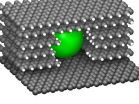(Press-News.org) An increase in temperatures due to climate change could mean that the Andorran ski resorts have a shorter season in the future, especially in lower areas. A study undertaken by the Polytechnic University of Catalonia and the Andorran Sustainability Observatory has analysed the specific case of the Pyrenean country and predicted that financial losses could come close to 50 million euros.
SINC. 22 de enero de 2013
One of the major challenges when studying climate change effects is to establish the relationship between physical impacts and environmental changes on the one hand, and between these factors and impact on humans on the other hand.
An international study enjoying the participation of the Polytechnic University of Catalonia has investigated the particular case of Andorra and has demonstrated a predicted increase in temperatures as a result of climate change will shorten the ski season in the resorts of the principality.
Furthermore, depending on the predicted climate change scene, a fall in income has been predicted along with lesser adaptation capacity provided by snow production machines.
Published in the 'Climate Research' journal, the study estimates a reduction in the number of skiers, especially in lower altitude resorts.
The mountain regions are considered especially vulnerable to the effects of climate change. "The rapid decrease in glacier mass, quantity and frequency changes of snowfall, level variations and biodiversity distribution are examples of how mountain ecosystems are highly sensitive," as explained to SINC by Marc Pons from the Sustainability Measuring and Modelling Laboratory of the Polytechnic University of Catalonia and the Andorran Sustainability Observatory and coauthor of the study.
Andorra is a small country in the middle of the Pyrenees between France and Spain with a population of approximately 80,000 inhabitants. It receives 10 million tourists each year according to data from Andorra Turisme 2010, especially during the winter season. Snow tourism is one of its main sources of income used for local development.
The study analysed three ski resorts in the principality: Grand Valira, Pal-Arinsal and Arcalís. And it is based on three possible scenarios as a consequence of climate change: the current situation and two possible future conditions.
Out of the last two, the first considers an increase of 2 ºC in the average winter temperature whereas the second is based on an increase of 4 ºC.
"We have employed these temperature increase figures based on two of the scenarios from the SRES report of the Intergovernmental Panel on Climate Change (IPCC), which are predicted as plausible for the Pyrenees at the end of the 21st century," states Pons.
The estimations have allowed them to analyse possible consequences, such as reduction of the ski season over time, the subsequent decrease in the number of skiers and thus what they would spend when visiting the region.
The importance of attitude
In the study, the altitude of skiable terrain is "one of the most determining factors in the vulnerability of the resorts," adds Pons. An assessment was made of the future snow cover of each one of the tourist resorts at various altitudes: 1500 metres, 2000 metres and 2500 metres.
Pons adds that studying different altitudes "is important to analyse the capacity of the resorts to compensate for climatic variability by using artificial snow production." He outlines that in recent decades, "resorts have invested significant amounts of money in artificial snow production."
In the case of Andorra, around 50% of the ski zones are covered by such snow production systems.
In addition, the researcher explains that there are "a great variety within the same region, which means that two resort groups now arise: those that are more vulnerable and those that are resilient, like Arcalís."
More specifically, if the temperature were to increase by 2 ºC in winter, only the lowest areas of Pal-Arinsal would be affected and the ski season would be shortened by 30%. This would mean a reduction in the number of skiers and investment in the region would be very small.
In contrast, in the case of a 4 ºC increase, the three tourist resorts would suffer from serious reductions in their lower altitude areas, where even the snow production machines could not even help to save the ski season. Nonetheless, the higher areas would remain stable throughout the season.
Delicate Pal-Arinsal and privileged Arcalís
The most critical of situations would be that of Pal-Arinsal, which could not even continue even with snow production machines. On the other hand, Grand-Valira and Arcalís would carry on, although with a shorter ski period.
In this context, a 15% decrease would be recorded in visitors with losses of approximately 50 million euros each season. In this case the resorts receiving the most visitors (Pal Arinsal and Grand Valira) would be affected both at the very beginning and at the end of the season.
Nonetheless, "aside from the figures themselves, the most important factor is the capacity to relate to physical changes," adds Pons.
The researcher points out that despite the influence of altitude, "there are other determining factors, such as orography and orientation, which have a strong influence and therefore should be considered in future studies."
This type of study helps governments to acquire deep and detailed knowledge on areas or resorts that are more vulnerable to the effects of climate change, the range of possible impacts and what adaptation measures are more suitable for each specific area."
###Referencia bibliográfica:
Marc Pons-Pons, Peter A. Johnson, Martí Rosas-Casals, Bàrbara Sureda, Èric Jover. "Modeling climate change effects on winter ski tourism in Andorra". Climate Research.
Climate change could cause massive losses in Pyrenees ski resorts
2013-01-23
ELSE PRESS RELEASES FROM THIS DATE:
The global gene pool of the goat is seriously under threat
2013-01-23
Amongst the range of domestic livestock species, the goat is not just the 'black sheep' but a resource of survival in impoverished countries, and many breeds are at great risk of disappearing. This is the case according to researchers of the Regional Service of Agro-Food Research and Development in their first monographic study tackling the global impact of this species.
A study from the Regional Service of Agro-Food Research and Development (SERIDA) has analysed the situation of the global goat population.
The study took into account the state of different breeds, ...
How the purple and pink sunscreens of reef corals work
2013-01-23
New research by the University of Southampton has found a mechanism as to how corals use their pink and purple hues as sunscreen to protect them against harmful sunlight.
Many reef corals need light to survive, as they benefit from sugars and lipids that are produced by their light-dependent symbiotic algae. However, in the shallow water of coral reefs, light levels are often higher than required by the corals, so paradoxically, the vital sunlight can become harmful for the algae and their hosts.
Apart from temperature, light stress is a major driver of coral bleaching ...
Santiago, Chile, will get drier and warmer
2013-01-23
This press release is available in German and Spanish.
Santiago de Chile/Leipzig. Already nowadays ten per cent or more of the population in the Metropolitan Region of Santiago de Chile is affected by extreme heat or floods. These threats will tend to increase due to the continuous expansion of the Chilean capital, the consequent changes in land use and the influences of climate change. Because of that, the international research project ClimateAdaptationSantiago (CAS) has developed, during the last three years, an Adaptation Plan to climate change for the metropolitan ...
Breakthrough: How salt stops plant growth
2013-01-23
Washington, D.C. —Until now it has not been clear how salt, a scourge to agriculture, halts the growth of the plant-root system. A team of researchers, led by the Carnegie Institution's José Dinneny and Lina Duan, found that not all types of roots are equally inhibited. They discovered that an inner layer of tissue in the branching roots that anchor the plant is sensitive to salt and activates a stress hormone, which stops root growth. The study, published in the current issue of The Plant Cell, is a boon for understanding the stress response and for developing salt-resistant ...
Reinventing retirement: New pathways, new arrangements, new meanings
2013-01-23
Retirement involves a set of institutional arrangements combined with socio-cultural meanings to sustain a distinct retirement phase in life course and career pathways. The articles outline that recent forces of change may lead to reinvention of retirement. There are factors that must be recognized as having a significant impact such as the fact that life expectancy and health status of adults over 60 has increased dramatically in recent years. Reinvention could involve change to one or more of the institutional arrangements supporting retirement. New financial risks and ...
Nanoparticles digging the world's smallest tunnels
2013-01-23
This press release is available in German.
The world's smallest tunnels have a width of a few nanometers only. Researchers from Karlsruhe Institute of Technology (KIT) and Rice University, USA, have dug such tunnels into graphite samples. This will allow structuring of the interior of materials through self-organization in the nanometer range and tailoring of nanoporous graphite for applications in medicine and battery technology. Results are now presented in the scientific journal Nature Communications (DOI: 10.1038/ncomms2399).
The tunnels are manufactured applying ...
Researchers create self-healing, stretchable wires using liquid metal
2013-01-23
Researchers from North Carolina State University have developed elastic, self-healing wires in which both the liquid-metal core and the polymer sheath reconnect at the molecular level after being severed.
"Because we're using liquid metal, these wires have excellent conductive properties," says Dr. Michael Dickey, an assistant professor of chemical and biomolecular engineering at NC State and co-author of a paper on the work. "And because the wires are also elastic and self-healing, they have a lot of potential for use in technologies that could be exposed to high-stress ...
Learn to be more understanding by watching The Bachelor (this season, anyway)
2013-01-23
A new USC study finds evidence suggesting that the brain works hard to understand those who have different bodies when watching them in action.
According to the study's lead author, the finding supports initiatives to include more individuals with physical differences in mainstream media – such as Sarah Herron, a contestant on ABC's The Bachelor this season, who was born with a foreshortened left arm.
"Generally, it's considered impolite to stare. But what these results suggest is that we need to look. It's through this visual experience that we're able to make sense ...
New way to identify 'smoked' grapes and wines
2013-01-23
With climate change sparking concern about an increased risk of wildfires, scientists are reporting development of a way to detect grapes exposed to smoke from those fires, which otherwise could be vented into bad-tasting wine. Their report on the method for detecting smoke taint in both grapes and wine appears in ACS' Journal of Agricultural and Food Chemistry.
Yoji Hayasaka and colleagues point out that Australia and other areas of the world are experiencing an increase in bush and wildfires, which may continue and intensify with global climate change. Smoke from those ...
Scientists underestimated potential for Tohoku quake. Now what?
2013-01-23
CORVALLIS, Ore. – The massive Tohoku, Japan, earthquake in 2011 and Sumatra-Andaman superquake in 2004 stunned scientists because neither region was thought to be capable of producing a megathrust earthquake with a magnitude exceeding 8.4.
Now earthquake scientists are going back to the proverbial drawing board and admitting that existing predictive models looking at maximum earthquake size are no longer valid.
In a new analysis published in the journal Seismological Research Letters, a team of scientists led by Oregon State University's Chris Goldfinger describes how ...





